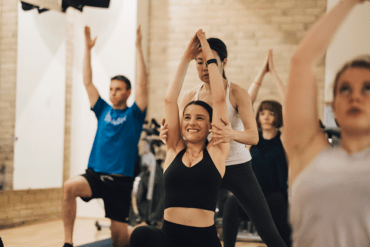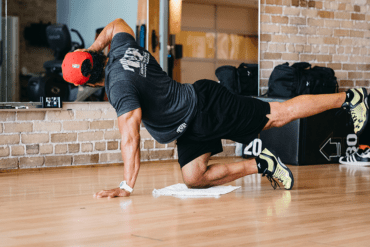We all know that the leg bone connects to the hip bone, but did you know that your primary hip bone also connects to your diaphragm?
Diaphragm 101:
The diaphragm is our primary breathing muscle. It is a dome shaped muscle situated at the bottom of the rib cage that functions by depressing downward like a bellow to pull air into your lungs from the outside by creating negative pressure inside the chest cavity.
Oxygen intake is very important for athletic performance, particularly during long duration aerobic activities like distance running. With time, metabolic byproducts of muscular contraction build up in the tissues limiting performance. Breathing provides working tissues with oxygen and removes these waste products at the same time. Functionally, the diaphragm also plays an important role in stabilizing the core. It forms the top of the inner unit, the deepest layer of abdominal tissues that surround our organs and spine.
To see what natural diaphragmatic breathing looks like, take a look at a young child. Their belly pops in and out as they breathe, their chest staying relatively still unless there are exerting themselves. We often see the exact opposite in adults. Lots of expansion in the chest and inward movement of the belly. By not using the diaphragm, breaths become shallow and less effective, as only the upper portion of the lungs expand. Functionally, a loss of diaphragmatic contraction interferes with activation of the inner core musculature which places more demand on larger superficial muscles for spinal stabilization. This dysfunctional pattern of stability is much less efficient and can become the root cause of a host of different injuries.
So what does all this has to do with your hips?
Today’s medical model tends to localize problems in the body to the area of symptoms alone, when in reality, the body is interconnected from head to toe. This becomes extremely apparent when we take a look at the musculature of the front of the hip.
The psoas muscle is a powerful hip flexor that starts at the bottom third of the spine, traveling downward through the pelvis and attaching to the front of the upper leg. At its point of origin, the psoas has a strong connection to the diaphragm. The psoas plays a major role in gait and spinal stability. Due to its location and size, it has a tendency to become hyperactive, especially when the inner core musculature isn’t working correctly. These factors create an interdependent relationship between the two muscles. If one is tight, it affects the other.
Clinically, I often see significant changes by simply re-establishing an awareness of the diaphragm and loosening the hips. Here are a couple of exercises you can try.
- 1. Lay on your back in a relaxed position, head supported, knees slightly bent.
- 2. Place one hand on your belly and the other on your upper chest.
- 3. Take a breath in, trying to breath from your stomach instead of your chest. You should feel motion on your belly hand first as your abdomen rises due to your diaphragm contracting.
- 4. Let the belly fall naturally during your exhale as your diaphragm relaxes.
- 5. Progress by trying to do the same thing standing. Try to incorporate sessions of diaphragmatic breathing throughout your day and while performing physical activities.
Stretching your psoas can also be helpful to release pressure from the lumbar spine and diaphragm.
- 1. Get in to a split kneel, keeping your hips aligned to the front (forward) and your pelvis in a neutral position (not tilted forward or back).
- 2. Engage your core and tuck your tailbone between your legs by performing a posterior pelvic tilt. You should feel tension develop at the front of the hip on the kneeling leg.
- 3. You can increase the tension through the front of your hip by maintaining the pelvic tilt and gently shifting your pelvis forward.
- 4. To ramp up the pull on your psoas, maintain the tension you have created with the pelvic tilt, then lift your arm on the same side and gently side bend your torso to the opposite side. Since the psoas originates on the side of the lower spine, this motion will greatly increase the pull through the region.
- 5. To maximize gains, perform deep diaphragmatic breathing in this position.



 Toe Extension
Toe Extension Ankle Dorsiflexion
Ankle Dorsiflexion Hip Flexion (Hamstring stretch)
Hip Flexion (Hamstring stretch)




